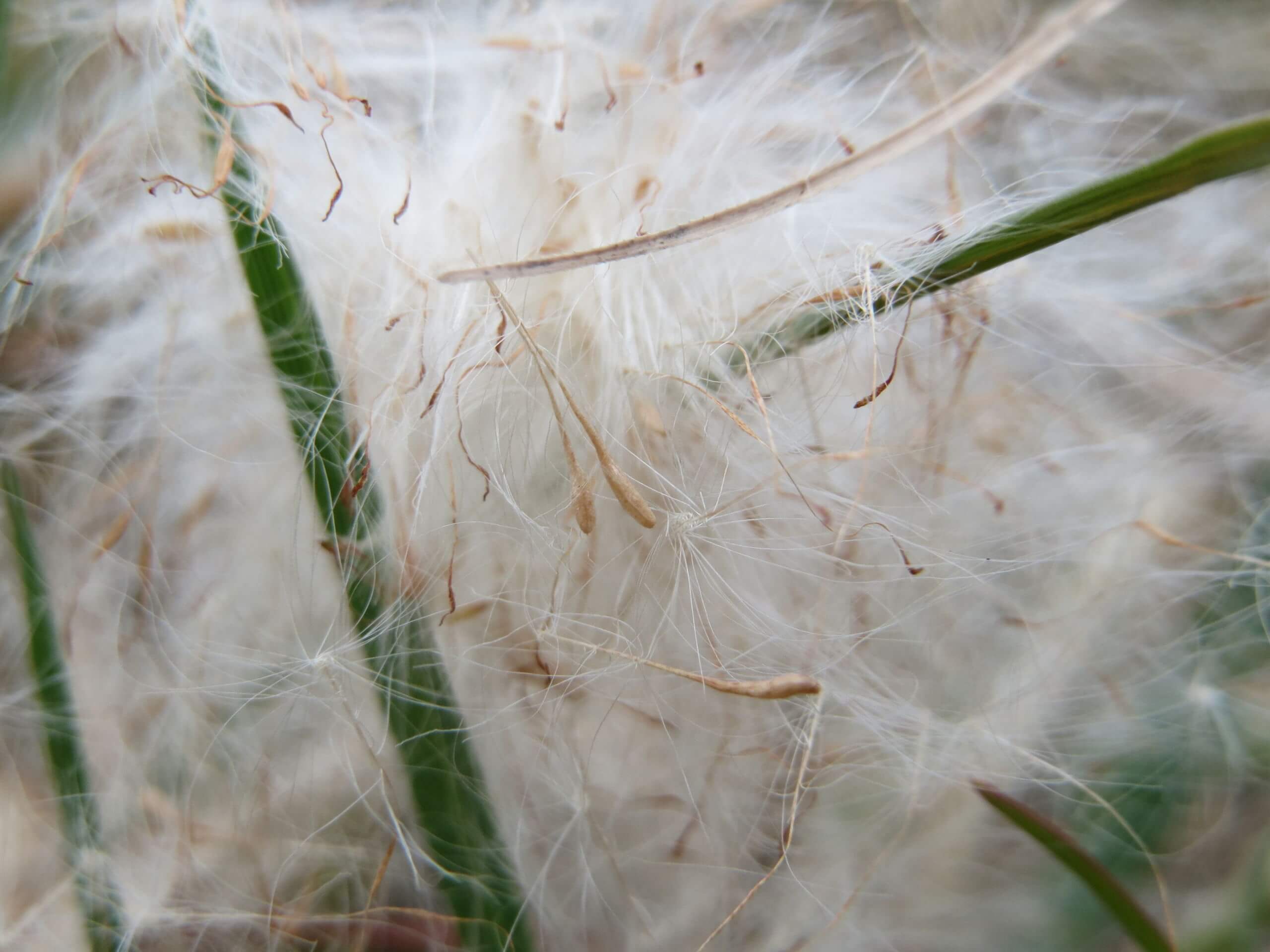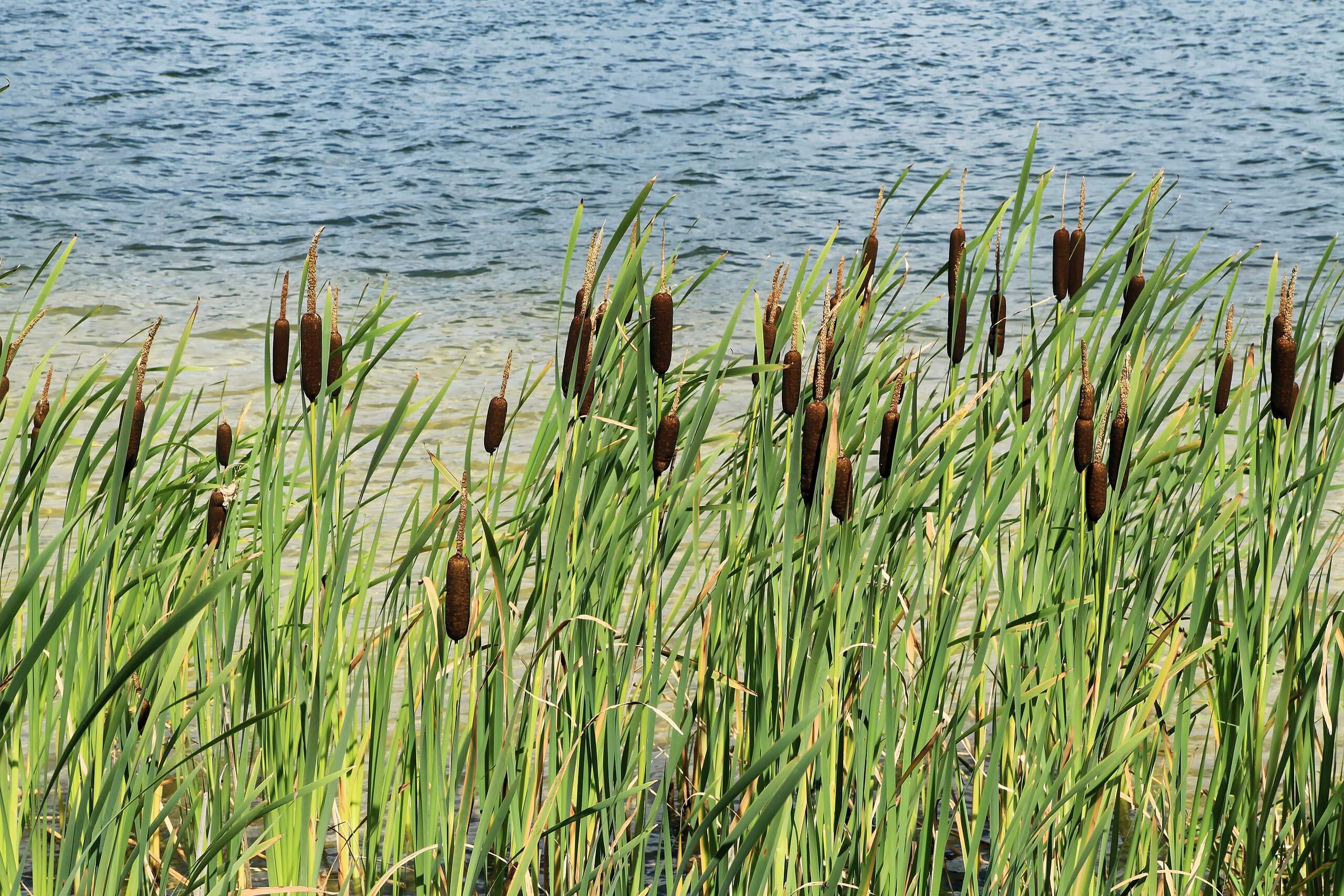Common cattail (Typha latifolia) is a species of plant you will likely be very familiar with. As its name suggests, it’s a very common find, especially along the margins of ponds, wetlands and lakes where it resides.
It’s a species that has dominated habitats around the World for centuries, and has developed a unique collection of other colloquial names. From ‘Common Bulrush and Greater Reedmace’ in the UK, ‘Raupo’ in New Zealand, and ‘Cumbungi’ within Australia.

Once established it can spread very quickly and can dominate habitats. Because of this, if you’re hoping to populate and landscape small garden ponds it’s usually advised to avoid including it. It’s such a common sight alongside bodies of water that is often overlooked as just part of the scenery. But common cattail has an interesting backstory and some valuable uses too!
Identifying Common Cattail
You should generally have no trouble correctly identifying common cattail. However, it’s distinguishing characteristics do alter throughout the seasons. The most recognisable feature has to be the long, dark brown, ‘sausage’ shaped seed heads that bend and sway in the wind. These initially appear as subtle flower heads in June to August, but can remain well into the winter months, as they develop and begin to drop their feathery seeds. The leaves tend to die back in later winter, allowing new shoots to emerge.

The broad, long, gray/green leaves are much shorter in length than common reed. Another very common wetland plant which is frequently found within similar habitats. Cattail generally reaches heights of roughly 2 metres tall, and truly are an unmistakeable sight at the edges of ponds and lakes.
They grow prolifically all around the World, within a mixture of different climates and altitudes. Whether an area of marshy ground, or the banks of slow moving freshwater, they tend to establish themselves quickly and become a very dominant species.
Common cattail has a very similar species known as narrow leaf cattail, or lesser reedmace (Typha angustifolia). As the name suggests, the leaves are much narrower, but another distinguishing feature is habitat. Narrow leaf cattail is generally found around areas of wetland along coasts and estuaries, or areas of brackish water. Their habitats overlap, so telling the two species apart can be difficult, but both can be harvested and eaten in the same way.
The Historic Uses of Common Cattail
Common cattail has a rich history of use within Native American groups throughout North America. It was used in many varying forms, from spiritual purposes where it was involved in ceremonies. To food preparation and as a building material. The young shoots and flower stalks were prepared as a vegetable, and the rhizomes, with their similarity to potatoes, were also cooked and used within many meals. The pollen was also collected, and used often within cooking. Whilst the rhizomes can also be dried and ground into a flour.
As well as food preparation, the broad leaves and fluffy seed heads of common cattail were utilised too. Unique and specialised woven items were created by different Native American groups, from baskets and ropes, to mats and door coverings. Whereas the downy seed heads could be used as bedding or tinder. It’s an amazingly abundant and sustainable resource that was used in its entirety.

Today, common cattail is not commonly foraged, however many people value its history and past usage among Native Americans. The plant is also still greatly relied upon by wildlife. Geese and moose graze upon the young shoots in spring. And the soft, downy seed heads are also often collected by small birds as nesting begins in early spring.
Eating Common Cattail
Almost every part of the common cattail is edible, from the roots to the pollen. The rhizomes and shoots are generally the most substantial parts of the plant that you can harvest. Whilst young shoots are edible, the mature leaves are avoided as they lack the sweet flavoring and crunch of newly emerging shoots. The rhizomes can be baked or roasted like potatoes, and have a slightly sweet flavoring.
The pollen can be collected in summer by covering the flower heads and shaking away the pollen into a bag or container. This can be used within many dishes, from pancakes to cupcakes. It tends to add a vibrant yellow coloring too!
Advice for Foraging Wild, Edible Common Cattail
Full of starch and a little protein, common cattail is a great wild food to turn to as a source of energy. As a widespread species, it’s brilliant to know that it can be turned to incase of any wild survival situation!
The plants grows best in shallow water, usually up to a metre deep, so waders may be necessary if you’re hoping to uproot a plant to harvest the rhizomes. For shoots, spring and early summer is the best time to harvest. Whereas the rhizomes tend to be sweeter in colder months, so autumn and winter is the optimum time to get out and forage!

Cautions to Consider
As a precaution, be sure to never forage for common cattail in areas where pollution or contaminants could be present. This includes ponds or lakes close to farmland or within urban areas. Try to forage within wild ponds, or even garden ponds at home, where you know pesticides or herbicides are not present. This is because common cattail acts as a ‘bioremediator’, absorbing and storing some pollutants from the water. They are frequently used in and around waste water treatment plants to remove pollutants and heavy metals like lead and zinc.
Whilst the common cattail is not an endangered species, it can often be found in wetlands or habitats that contain protected species. Foraging is often disallowed in these areas, so take care to check for any signage and follow accordingly.
A widespread and vigorous plant, it really is a fantastic species to forage. Easily identifiable and with such a rich history of use. It’s a plant so common in most landscapes it can often be completely overlooked and undervalued. Hopefully you’ll see this versatile species in a new light!
—————Written by Hannah Sweet
Hannah is a freelance writer and graphic designer from the UK. With a penchant for travelling, photography and all things botanical, she enjoys writing about a wealth of topics and issues, from conservation and slow living, to design and travel. Learn more about her writing and design services at www.sweetmeanders.co
Many of our readers find that subscribing to Eat The Planet is the best way to make sure they don't miss any of our valuable information about wild edibles.
See our privacy policy for more information about ads on this site






